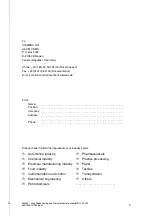
Detecting and Correcting Faults
6-2
SM 335 – High-Speed Analog Input/Output Module for the SIMATIC S7-300
6ES7 335-7HG00-8BA1
6.1
Principle of diagnostics
LED
When an error or fault occurs on an SM 335, the SF LED on both the CPU and the
SM 335 lights up.
(Diagnostics must be enabled.)
Parameterize diagnostics
Enable the diagnostic interrupt on the SM 335 for an entry to be made in the CPU
diagnostic buffer if an error occurs. A diagnostic interrupt is also generated and the
diagnostic OB (OB 82) is invoked in the CPU.
See Subsection 3.2.2 for information about how to initialize the SM 335 using
HW Config.
You can also enable diagnostics when the parameters are transferred with system
function WR_PARA. Descriptions of the SM 335 parameters can be found in Sub-
section 3.3.2.
Diagnostic buffer
The diagnostic buffer is a buffered memory area in the CPU, which stores the diag-
nostic events in the order in which they occurred.
For troubleshooting, the user can read out the exact error cause with STEP 7 (tar-
get system
→
module state) from the diagnostic buffer.
Diagnostic OB 82
If you have enabled diagnostic interrupts, the SM 335 generates one. When a
diagnostic interrupt is generated, the diagnostic OB (OB 82) is invoked in the CPU.
You can program your response to the error/fault which caused the interrupt in this
OB.
See Section 6.3 for an example of how to read out the diagnostic data in OB 82.
Diagnostic data format
The SM 335 diagnostic data can be read with system function 59. See Subsection
3.4.2 for information about data formats.
Advantages of a diagnostic interrupt
OB 82 is invoked automatically when diagnostic interrupts are enabled, and makes
the module start address available as part of the local data.















































